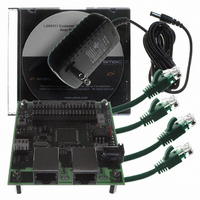EVB9311 SMSC, EVB9311 Datasheet - Page 274

EVB9311
Manufacturer Part Number
EVB9311
Description
EVALUATION BOARD LAN9311-NU
Manufacturer
SMSC
Series
0133r
Datasheet
1.LAN9311-NU.pdf
(460 pages)
Specifications of EVB9311
Main Purpose
Interface, Ethernet
Embedded
No
Utilized Ic / Part
LAN9311
Primary Attributes
2 Ports, 100BASE-TX/10BASE-T, Managed
Secondary Attributes
2 PHYs with HP Auto-MDIX, Auto- Flow Control, 32-bit CRC, MDI/MDI-X
Lead Free Status / RoHS Status
Lead free / RoHS Compliant
Other names
638-1076
- Current page: 274 of 460
- Download datasheet (5Mb)
Revision 1.7 (06-29-10)
BITS
7:6
1:0
5
4
3
2
BackOff Limit (BOLMT)
The BOLMT bits allow the user to set the back-off limit in a relaxed or
aggressive mode. According to IEEE 802.3, the Host MAC has to wait for a
random number [r] of slot-times(see note) after it detects a collision, where:
(eq.1)0 < r <
The exponent K is dependent on how many times the current frame to be
transmitted has been retried, as follows:
(eq.2)K = min (n, 10) where n is the current number of retries.
If a frame has been retried three times, then K = 3 and r= 8 slot-times
maximum. If it has been retried 12 times, then K = 10, and r = 1024 slot-
times maximum.
An LFSR (linear feedback shift register) 20-bit counter emulates a 20 bit
random number generator, from which r is obtained. Once a collision is
detected, the number of the current retry of the current frame is used to
obtain K (eq.2). This value of K translates into the number of bits to use from
the LFSR counter. If the value of K is 3, the Host MAC takes the value in
the first three bits of the LFSR counter and uses it to count down to zero on
every slot-time. This effectively causes the Host MAC to wait eight slot-
times. To give the user more flexibility, the BOLMT value forces the number
of bits to be used from the LFSR counter to a predetermined value as in the
table below.
Thus, if the value of K = 10, the Host MAC will look at the BOLMT if it is 00b,
then use the lower ten bits of the LFSR counter for the wait countdown. If the BOLMT
is 10b, then it will only use the value in the first four bits for the wait countdown,
etc.
Note:
Deferral Check (DFCHK)
When set, enables the deferral check in the Host MAC. The Host MAC will
abort the transmission attempt if it has deferred for more than 24,288 bit
times. Deferral starts when the transmitter is ready to transmit, but is
prevented from doing so because the CRS is active. Deferral time is not
cumulative. If the transmitter defers for 10,000 bit times, then transmits,
collides, backs off, and then has to defer again after completion of back-off,
the deferral timer resets to 0 and restarts. When this bit is cleared, the
deferral check is disabled in the Host MAC and the Host MAC defers
indefinitely.
RESERVED
Transmitter enable (TXEN)
When set, the Host MAC’s transmitter is enabled and it will transmit frames
from the buffer.
When cleared, the Host MAC’s transmitter is disabled and will not transmit
any frames.
Receiver Enable (RXEN)
When set, the Host MAC’s receiver is enabled and will receive frames.
When cleared, the MAC’s receiver is disabled and will not receive any
frames.
RESERVED
Slot-time = 512 bit times. (See IEEE 802.3 Spec., sections 4.2.3.25
and 4.4.2.1)
2
K
BOLMT Value
00b
01b
10b
11b
DESCRIPTION
DATASHEET
# Bits Used from LFSR Counter
274
Two Port 10/100 Managed Ethernet Switch with 16-Bit Non-PCI CPU Interface
10
8
4
1
TYPE
R/W
R/W
R/W
R/W
SMSC LAN9311/LAN9311i
RO
RO
DEFAULT
Datasheet
0b
0b
0b
0b
-
-
Related parts for EVB9311
Image
Part Number
Description
Manufacturer
Datasheet
Request
R

Part Number:
Description:
FAST ETHERNET PHYSICAL LAYER DEVICE
Manufacturer:
SMSC Corporation
Datasheet:

Part Number:
Description:
357-036-542-201 CARDEDGE 36POS DL .156 BLK LOPRO
Manufacturer:
SMSC Corporation
Datasheet:

Part Number:
Description:
357-036-542-201 CARDEDGE 36POS DL .156 BLK LOPRO
Manufacturer:
SMSC Corporation
Datasheet:

Part Number:
Description:
357-036-542-201 CARDEDGE 36POS DL .156 BLK LOPRO
Manufacturer:
SMSC Corporation
Datasheet:

Part Number:
Description:
4-PORT USB2.0 HUB CONTROLLER
Manufacturer:
SMSC Corporation
Datasheet:

Part Number:
Description:
Manufacturer:
SMSC Corporation
Datasheet:

Part Number:
Description:
Manufacturer:
SMSC Corporation
Datasheet:

Part Number:
Description:
FDC37C672ENHANCED SUPER I/O CONTROLLER WITH FAST IR
Manufacturer:
SMSC Corporation
Datasheet:

Part Number:
Description:
COM90C66LJPARCNET Controller/Transceiver with AT Interface and On-Chip RAM
Manufacturer:
SMSC Corporation
Datasheet:

Part Number:
Description:
Manufacturer:
SMSC Corporation
Datasheet:

Part Number:
Description:
Manufacturer:
SMSC Corporation
Datasheet:

Part Number:
Description:
Manufacturer:
SMSC Corporation
Datasheet:

Part Number:
Description:
Manufacturer:
SMSC Corporation
Datasheet:











